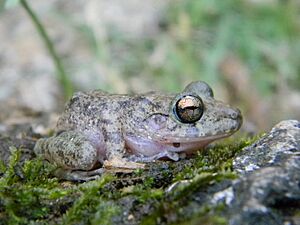Craugastor pozo facts for kids
Quick facts for kids Craugastor pozo |
|
|---|---|
 |
|
| Conservation status | |
| Scientific classification | |
| Genus: |
Craugastor
|
| Species: |
pozo
|
| Synonyms | |
|
Eleutherodactylus pozo Johnson and Savage, 1995 |
|
The Pozo Turipache rainfrog (scientific name: Craugastor pozo) is a type of frog that belongs to the Craugastoridae family. This special frog lives only in one specific area, which means it is endemic to Mexico. You can find it in the western hills and highlands of Chiapas. Its name, pozo, comes from a local place called El Pozo, also known as Pozo Turipache or Pozo La Pera.
Contents
What Does the Pozo Turipache Rainfrog Look Like?
Male Pozo Turipache rainfrogs are about 3.7 to 4.8 centimeters (1.5 to 1.9 inches) long. Females are larger, measuring about 4.6 to 8.1 centimeters (1.8 to 3.2 inches) long. These measurements are from their snout to their bottom.
Key Features of This Frog
This frog has a sharp ridge on its face called the canthus rostralis. It also has a clear eardrum, known as the tympanum. Its back is usually brown. You might see a few black lines or spots there. These spots are linked to small ridges on its head and shoulders.
Color and Markings
The front part of its head is a light brown color. A dark bar separates this area from the back of its head. The frog often has noticeable dark bars on its lips and legs. A black line runs along the bottom edge of the ridge above its eardrum. Its sides are creamy white with bold, dark brown patterns. Large adult male frogs have vocal slits, which they use to make sounds.
How Scientists Identified It
For a while, scientists thought Craugastor pozo was the same as another frog, Craugastor brocchi. But later, they realized it was a unique species of its own.
Where Does the Pozo Turipache Rainfrog Live?
This frog lives in wet forest areas. It prefers places that are 700 to 1200 meters (about 2,300 to 3,900 feet) above sea level. You can find them on the forest floor. They often hide under fallen leaves among limestone rocks and in limestone caves.
Daily Life of the Rainfrog
During the day, these frogs stay hidden. But at night, they become active. They move around on the forest floor and climb onto low plants.
Why Is This Frog in Danger?
The Pozo Turipache rainfrog is a rare species. Its home, the wet forest, is slowly disappearing. This loss of habitat is a big threat to the frog. Sadly, this frog is not known to live in any protected areas. This means its habitat is not safe from being destroyed.


